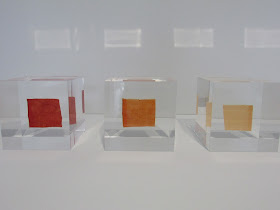Having been impressed by Barrada's abstract textile compositions which I encountered at Pace's excellent Creating Abstraction staged two years ago in the gallery (here), an excellent exhibition about the female contribution to the global abstract movements in art, I felt I had to visit this solo show to find out more about this aspect of her practice. I recently posted about the current textile show at Barbican, Unravel: The Power and Politics of Textiles in Art (here), which originally featured a couple of Barrada's textile appliques but due to a political decision by those at Barbican that exhibition appears itself to be unravelling with Barrada along with other artists deciding to withdraw their work in protest. The works on display here are mainly created using the textile technique of appliqué in which pieces of cloth are sewn onto a larger piece to create a picture or pattern. There are different fabrics employed such as rich velvets which have a lustrous sheen and reflect the light beautifully creating a new dimension and dynamic to the pieces. I like the fact that certain edges of fabric are left frayed adding further levels of texture. There are also cloths which have been dyed in 'The Mothership' Barrada's natural dye garden and studio situated in Tangier. We encounter blues created from indigo leaves like woad, reds and pinks extracted from madder roots, and oranges and yellows from plants such as pomegranate and weld. These are fixed into the fabric with a mordant - a substance which gives the dyed fabric better light-fastness and durability. "Mordant" means to bite, or biting in French hence the title of the exhibition. These fabrics have a lovely range of colours some very bold, others subtly nuanced. Walking through the exhibition I thought it possible to detect a range of credible influences on these works such as Rothko's fuzzy colour fields, the geometry of Constructivism, as well as hard-edge abstract geometry. One could even perhaps detect an influence from the textile pieces of Louise Bourgois. The ways in which the various cloth elements are laid down create a certain rhythm and surface tension in the pieces which has the eye darting back and forth finding patterns. There are some lovely little fabric samples set in blocks of clear perspex which refract the the light playing optical tricks on the eye. Barrada shows just like the other artists who work in textiles at the Barbican's Unravel exhibition across town just how important fabric can be as a medium for artistic expression.
Sunday, 28 April 2024
Yto Barrada: Bite the Hand
Yto Barrada, Untitled (Colour Wheel I), (2024)
Yto Barrada: Bite the Hand
until 11th May
Pace Gallery
5 Hanover Square
London
Sunday, 21 April 2024
Frank Auerbach: The Charcoal Heads
This is another exhibition of drawing in the capital so soon after that of the Impressionists (here), which closed just weeks ago at the Royal Academy of Arts. That show took in a range of drawing techniques which were executed in a variety of media and subjects which ranged from portraits, figure studies and landscapes. This exhibition though focuses on Auerbach's early charcoal portrait drawings with a few of his signature oil paintings in a heavy impasto style added to complement the drawings. The one thing that this show and that of the Impressionists have in common is the idea that drawings can be thought of as complete works of art in and of themselves and not just as preliminary studies for paintings. I published a post on Auerbach's most recent self-portraits (here) last year, and it is interesting to look at the evolution of his style and technique. The drawings at the Courtauld were created against the backdrop of a drab post-war London. They eloquently capture the mood of the time which was starkly atmospheric. There is also a sense of cloying claustrophobia about them. The sitters for the portraits are drawn from a very select group of the artists close friends and for the most part the sitters look out avoiding the gaze of the viewer only Auerbach's gaze confronts us head on. The resulting drawings look as though they were fairly arduous to sit for. This is compounded by Auerbach's technique in which he would completely erase the labours of his work after each sitting and then resume the drawing anew on the same piece of paper at the next session. Auerbach continued in this way until he was content with his work and consider it finished. This must have been incredibly frustrating for the sitters who would have required lots of patience and stamina. As a result of the artists continued erasing and drawing into the paper surface it would become weak and worn through. Auerbach though, would persist in his work and just patch the paper ground with other pieces of paper. The resultant patched collaged surfaces have the disconcerting effect of leaving the subjects looking as though they've had constructive cosmetic facial procedures Frankenstein-style. As powerful as the drawings are here it is one of the few paintings on display that most captivated me. I'd seen the portrait Head of Gerda Boehm, 1964, (here), a couple of years ago at the Barbican's Postwar exhibition which enchanted me then and still does so again here with its rich yellow ochre background and luscious thick impasto brushwork. Perhaps it is as a result of age but Auerbach's more recent works seem less intense, more relaxed in comparison to these drawings. This sense of relaxation has led to looser more abstracted artworks than these intense charcoal drawings. It is a testament to the man and his love of art that he is still producing work at the grand old age of 92.

Frank Auerbach: The Charcoal Heads
until 27th May
The Courtauld
Somerset House
Strand
London
WC2R


































































